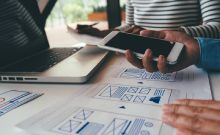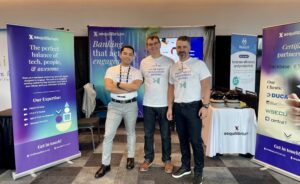“Don’t you guys make it look pretty?”
This is a question often overheard from people who don’t really know what product designers do, or from those who are new to the industry. So what do product designers do?
The role of a Product Designer.
Let’s try an experiment. Walk around the teams in your room and ask a developer, a PM, a UI designer, a UX designer, and maybe a QA engineer what a product designer does. Now formalize your findings… I bet you will find they all vary and some may even be shocking. This may be the right time to get your teams together and host a fireside chat to discuss what a product designer actually does.
It’s not uncommon in many organizations to have different opinions as to what a Product Designer does. I have worked for some of the biggest organizations, and even there it was a grey area. If you really get into it though, it makes sense: product design and the whole digital design ecosystem has moved and evolved so fast in the last two years that role specifics can confuse even the most seasoned designer.
This confusion may be attributed to competing and complementary niche roles. Specialists in UI design, UX design, information architecture, UX copywriters, mobile designers, web designers, interaction designers, animation designers, and so on, can often be lumped together or crossover in responsibilities.
I hold the role of Director of Product Design at aequilibrium, a digital product agency in Vancouver, BC, and I like to consider myself akin to a conductor of the digital orchestra. In my experience, product designers typically come from one or many of the listed specialist roles and have adapted to another, then another, building out their toolkit over many years (and late nights) to become the holistic, data-driven, results-based, pixel-perfect, bleeding-edge technology masochists that we are. Although the role is still much in flux as the industry changes day by day, this is my attempt at conveying the breadth, wealth, and utility of this sadly underestimated role.
Solving problems with design.
Product design is about problem-solving, and product designers seek to improve the experiences of products by solving complex design problems. If you look at your Product Designer as someone that makes your solution look presentable, look again. They are there to help you identify, investigate, and validate the problem. Ultimately, he or she is there to craft, design, test, and ship the solution.
“Product design is not purely aesthetic.”
They do so by using a variety of skills:
- Animating
- Prototyping
- Coding
- Research
- Visual
- Interaction design
- Psychology
- Business strategy
“Present a product designer with a solution, and they will tell you what’s wrong with it.”
A Product Designer will never commit to one idea from a client or a manager. Instead, they will explore various alternatives to solve a single problem. Using analytics and gathering existing user data are critical to finding the right solution, as is employing cross-functional teams from every corner of the business to help brainstorm as many solutions as possible.
The designer process.
Product Designers use wireframes and prototypes to validate their designs. After user validation, they will provide several fully baked low-fidelity concepts (more wireframes, and workflows) that will aim to solve the problem at hand. With a clear strategy for how, when, and what to A/B test, the build and release plans will become evident.
“A product designer will design the solution until the problem changes.”
During active sprints, Product Designers will join the development team to see through their solution. UI audits, micro interactions, App Store requirements, you name it, are all part of the Product Design process. On smaller teams, Product Designers will also work with marketing and stakeholders to ensure the story is consistent with the product through the development of social assets and websites.
What I find most personal is that Product Designers will often take part in the continuation of a product long after the first version has been released. They will follow up on data and metrics to continue validating their design, possibly until the end of time.
A marketing mindset.
One of the major areas of work that is often overlooked in the role of the Product Designer is branding. It is part of the Product Designer’s job to ensure the product is designed on brand; if the product doesn’t deliver what the brand promises and what the stakeholders have asked for, users will not stick around. Trust me on this one.
Product Designers are therefore regarded as the caretakers of the business’ foundation. Any such discrepancies will ultimately cause the product to fail. As such, it’s of utmost importance for the Product Design team to work closely with the Marketing team.
Product design is constantly changing.
This is an ever-evolving world. We all feel it. That which was extraordinary yesterday is mundane today and stale tomorrow. Product design is still trying to figure out its place within this highly reactive space. Hell, half the platforms we have to design for today didn’t even exist a couple of years ago. And you can be sure there will be even more in the years to come with even more complex experiences to discover and create solutions for.
Product design is thus adaptive, agile, and flexible. As Product Designers, we need to understand that while good, well thought through design is timeless, nothing is forever and we need to be open to whatever change may come our way.
A strategy I enjoy deploying is preparation. By understanding and keeping up with industry standards and the latest tech and tools, I’m easier able to tackle new ideas and iterations. Microinteraction prototyping using InVision Studio is an example of a tool I recently started to learn, along with my design team where we learned the basics together. We currently spend any free time between projects playing around so that the following week we all have something cool to show each other. So far it’s been a lot of fun, and one of the meetings each week that I actually find myself looking forward to the most. I encourage all Product Design teams out there to consider following our lead. It’s an excellent way to stay apprised of the latest developments and to continuously hone your skills. If we deem the new process a great value-add to our team and also to our clients we start assimilating it into our design process–– we win and clients win.
Product design today.
We’re just starting to wrap our heads around Product Design, and that’s ok because this industry and the technology behind it moves so fast we are running to keep up with it. New capabilities in codeless prototyping, microinteractions, animations, and work tools like the aforementioned InVision Studio not only allow us to push the limits of product design but also the capabilities of the tools we used to create and show them.
Unfortunately, product design has classically been seen as purely aesthetic. “Make it pretty,” they say. This is a perception we have to change. We are the architects of the user experience! And as such, it is our responsibility to educate those around us, above us, and under us, about what it is we actually can and should be doing.
When you hire a Product Owner, you likely do so because this person is well-versed in a wide range of disciplines; they understand some front- and backend coding, timing, budgeting, business valuation, analytics, management, etc. In many ways, this is how you should be thinking about hiring Product Designers. Sure, they might have a beautiful portfolio, but can they be a key player throughout the entire product development process? A good Product Designer should know a bit of animation, prototyping, coding, user research, visual and interaction design, market validation modeling, customer scenario, and journey mapping modeling. They should know when to deliver wireframes, and when to deliver pixel-perfect mockups. They should know when to use animation, and when to prototype. They should know how to validate a product hypothesis, communicate and gather data on what the user wants, and aggregate this data into business intelligence information to the stakeholders. Last but not least, they should know how to convincingly communicate their solutions.
Product design is evolving.
In my time at aequilibrium, we’ve gone from a handful of mainly Visual Designers to a full-stack team comprised of Product Designers, User Researchers, Prototypers, and UX Copywriters.
We’ve gone from being at the end of the product development and design cycle (“We need buttons on this new feature we’re going to launch”) to the very forefront (“We want to investigate all the possible ways of enabling our users to interact and explore our product”). In a nutshell, you could say that we’ve truly gone from being a cursory consideration as the beauticians of the product to the curators of that which matters most—the user experience.











